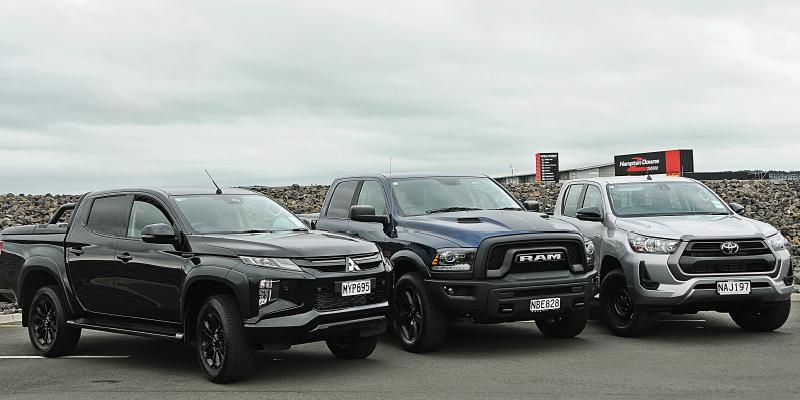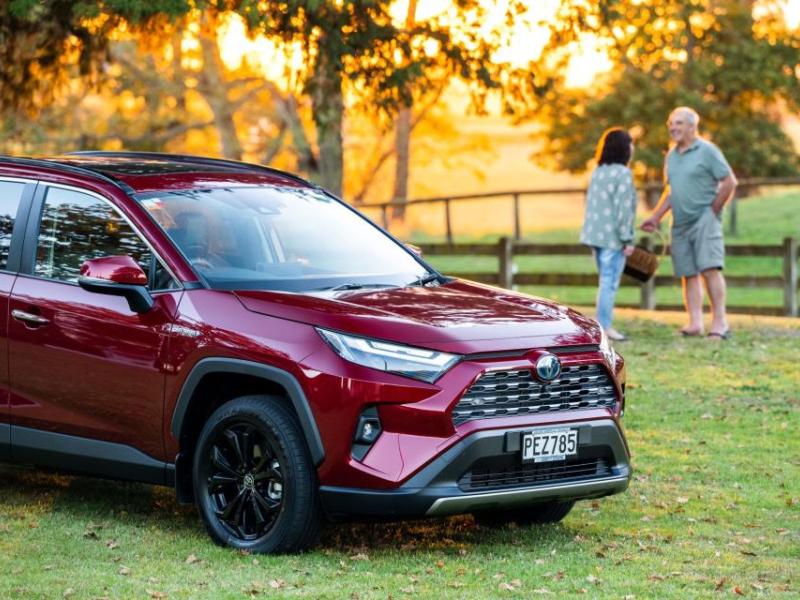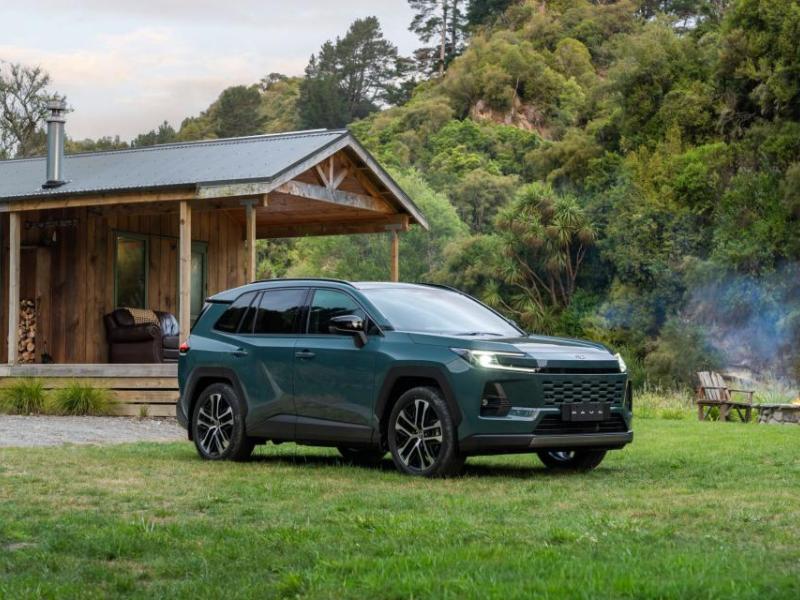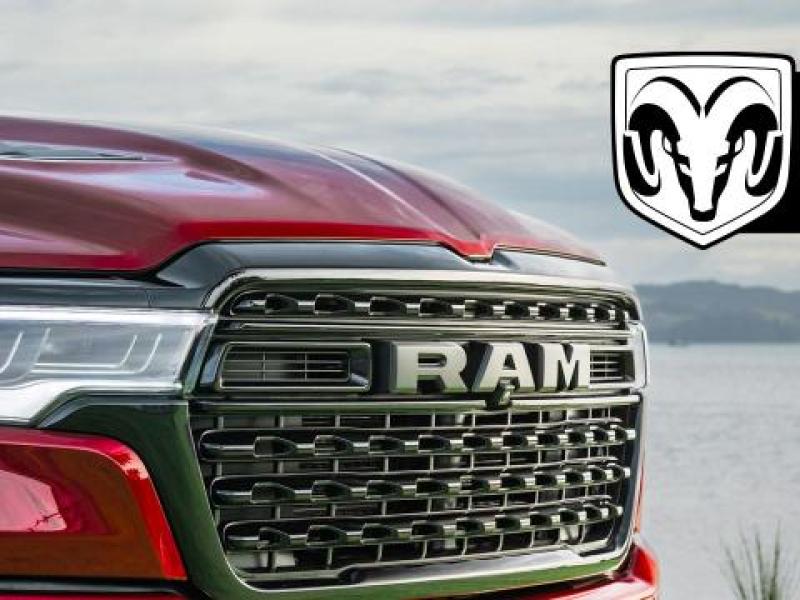Together for just a day, three very different utilities – a RAM 1500, Toyota Hilux and Mitsubishi Triton – became los tres amigos as they ventured from Auckland to and from Hampton Downs for a play date together at the venue’s new off-road park!
Three personalities, three ways of doing broadly similar duties. Three takes on that essentially Kiwi desire to have a vehicle that works hard, plays hard, washes up clean. To borrow from the blurb in the brochure for one of these three: “Gear up and get out there. Forget the weather, this is New Zealand. Any mud you encounter will be worn with pride.”
Three different vehicles, three different market segments. Two are about benchmarking their latest versions, with new trim packages and styling, gentle upgrades everywhere. The third is a modern take on the origin of utes or pickups; a reminder of how these vehicles evolved.
One of our trio has been an established leader in the double cab diesel ute arena for decades; it has been the ‘go-to’ for tradies, recreational users and governmental users since Crumpie made rough, tough bush blokes so trendy you’d see them in Queen Street. The Toyota Hilux arguably created the double-cab diesel ute segment three decades ago, and it has come a long, long way since then.
One is a challenger to that title, and has begun to make inroads to those roles. From humble – and mainly petrol-powered – stock, it has rapidly evolved into a double-cab diesel ute offering stacked with features and value, underpinned by a chassis and drivetrain with serious offroad ability. The Mitsubishi Triton Black Edition throws some serious opposition in the path of its rival.
The third embodies all that is great and good about the original ‘pickup’ segment in the nation that spawned these immensely useful vehicles. In America’s month of drama, decision and denial, we got our hands on the very new yet quite old school RAM (nee Dodge) 1500 Warlock. This is a team, tool and toy hauler par excellence. Could anyone say no to this mighty beast? We certainly couldn’t.
The first two proudly wear their Japanese design ‘language’ in their sharply-cut and angular snouts, showing similar frontal profiles until examined closely. High-set headlight clusters house LED light packs, the grilles are broadly similar though of course proudly bearing their distinctive brand identifiers. Bonnet shapes are similar, with slight scallops at each edge that slightly improve vision in tight turns and offroad. The lower half of the nose in each case is clad in sensible plastic (colour-keyed for the Hilux, black for the very black Triton) to shrug off those building site bumps and the occasional close brush with grassy banks out in the wilds.
The RAM is simply purest RAM, ‘our’ Warlock finished in a deep blue with black satin applique to the bonnet. In this spec the front end is less shouty than the bright chrome of other RAMs but no less business-like.
There are two substantial pull-hooks styled into the all-black bumper below the ‘Rebel’ grille, and a pair of subtle nostrils in the bonnet (should we call something this size a bonnet? It seems the Americanism, ‘hood’ is more fitting).
Of the three, the RAM has the most ‘old school’ light clusters, though each headlight encloses an HID main lamp. Also old school in a charming way is the radio aerial, set into the front guard in true 1960s-1970s.
Smooth operator!
Under the hood of the Warlock is a V8 – of course – though a relatively modest 5.7-litre that almost seems dwarfed in such a massive engine bay. It’s a smooth unit, burbling its way down the highway and out onto narrow rural roads, up sketchy clay tracks and in between unforgiving pine trees during our all-too-brief time together.
All three, of course, have comprehensive active and passive safety feature packages.
Power is where the three vehicles begin to diverge.
In the Toyota corner
The Hilux has been ‘THE’ ute for the job – any job! – since the good old days of the 1990s, when the power companies and Government Departments used to buy them by the job lot, having been starved of robust offroad vehicles since the FJ40’s production run ended.
If you needed a vehicle that could get out there and back and carry a decent payload of fencing gear, hut repair supplies or just power tools, Hilux was the ute for the job.
These days it’s more sophisticated, with the smoothest auto behind a modern 2.8-litre turbodiesel that provides 150kW and more importantly 500 Nm of seamless torque, the latter reached at 3,400 rpm, Both figures are increases over the outgoing version.
That peak torque figure on this diesel automatic model has been ramped up by 11 percent; there have been modifications to the cylinder block, pistons, turbo design and cooling system.
Backing the revised engine is an automatic that must be a class leader, smooth and fuss free with ratio steps that make on-ramps a pleasingly linear process while steep downhills can be idled down with confidence thanks to its Hill Descent software.
It’s never allowable to do a test like this and forget to mention towing capacity – that’s what many buyers want to do, and what they want to know is “what’ll she pull?” Toyota’s answer is 3500 kg, braked. To put that into perspective, it’s more than enough to tow, launch and recover your 1900 kg Surtees Workmate 700 hardtop fizzboat (or your preferred equivalent) anywhere you please. Or drag that nice shiny 1880 kg Jayco Journey duallie caravan (or again your preferred equivalent) to your favourite bush or beach paradise. In either case, you have tray-based payload to spare as well.
Toyota has tweaked the rear suspension of the eighth-generation Hilux, with longer leaf springs to suppress road vibrations, wider spacing of the springs for stability while cornering under load, and revised attachment points to promote steering stability. The Hilux has retuned spring rates, shock absorbers and suspension bushes as well as revised cabin mounts. These improvements are designed to deliver a more agile handling response and improve ride comfort, particularly when unladen on country roads and over speed humps.
Our test vehicle came without a canopy and with a serviceable but perhaps basic clip-in tray liner; upgrading to the former would be a must and there are a range of aftermarket liners that would add to the tray’s longevity and looks.
Lest the Queen Street Crumpies forget the workmanlike origins of the Hilux, it is still possible to buy one shod with tough resilient steel wheels. Our SR-spec test vehicle came equipped that way, which made for a striking contrast with the painted, polished and clear-coated alloys we are accustomed to. The SR variants have 17” black steel wheels with all-terrain 265/65R17 Bridgestone tyres. Strange choice? Perhaps, but it allows the owner to roll into a tyre shop and buy the alloys they prefer. Actually, that makes it a clever offering – the buyer gets to personalise their ute from day one, stack the steelies in the shed for when it’s time to upgrade vehicles.
The 2021 Hilux gets a full five star ANCAP safety rating thanks to a range of electronic braking and traction-control technologies, emergency stop signal, reversing camera, seven airbags, and seatbelt reminders for all seats. All variants have Toyota’s Safety Sense package featuring a pre-collision system with autonomous emergency braking for vehicles, pedestrians and cyclists; dynamic radar-based cruise control, lane departure alert with ‘yaw assist’ and road sign assist.
Trailer sway control is standard on all variants, as is active traction control.
And now, the Mitsi!
Mitsubishi’s Triton uses the company’s well proven 2.4-litre Mivec direct-injection turbodiesel and backs it with a six speed auto transmission. The latter has a sports mode, though it’s hardly needed with a high torque diesel and six ratios doing the work. Power and torque of this all-alloy four cylinder engine are 137 kW and 430 Nm respectively, but the Triton doesn’t feel any less capable on or off road alongside Hilux. Peak torque is developed at 2,500 rpm, just where it should be.
The Super Select II four wheel drive system is activated by a rotary knob. We did try low range but for most off-road uses the high range four-wheel drive is all that is needed. Low is super low, great for sidling around tricky narrow places or backing the caravan, but high four is the go-to for most off-roading. ‘High range four’ can even be selected at speeds of up to 100 km/h.
Like the Hilux, the Triton will tow 3500 kg. It has electronic trailer stability assist for those fish-taily moments when you wish you’d paid more attention to where you put the heavy stuff on that trailer. On-tray payload is 950kg – almost a tonne, and very handy.
On test, the Triton is like that old mate you might only meet once a year – conversations pick up where they left off, and the feeling is comfortable and familiar – blended with a catch-up of what’s new and interesting for both mates. This ute has been in NZ4WD many times in recent years, and each time it has demonstrated its technological improvements, always couched in a package chock-full of value. This test was no different – we picked up the Black Edition from Newmarket and were immediately plunged into Friday afternoon motorway mayhem.
Though it is possible to do something like this all-black look and make an awful hash of its application, the Triton really makes the look work. There’s a custom factory-fitted body kit, special surrounds for the LED lights, and glossy black 18-inch allow wheels. Like all our three amigos, the Triton was shod in a road-oriented tyre that reflects how most of us would use it most of the time. The tyre spec is 265/60x18, and there’s a full sized alloy wheel spare too.
On the subject of wheels, is anyone tired of the trend of machining bright alloy ‘highlights’ onto a wheel yet? Hands up all those who prefer a whole-colour wheel, black or otherwise.
Let’s not even consider the stupidity of a four wheel drive on 20-inch rims with low-profile knobbly tyres either. You need sidewalls for comfortable riding and for reliable offroad and on-road driving. You need road-oriented tread so you don’t chew out expensive gnarly tyres in the supermarket car park. Like the Hilux and the RAM, the Triton avoids ‘dubs’ and dumb tyres. Thank goodness for that.
The Triton’s safety package wins it a five star ANCAP rating and includes forward collision mitigation, lane departure warning, blind sport warning and rear cross traffic alert. Pleasingly, these features don’t have that ‘hand of God’ intrusiveness of some. Absent is that ‘nannying’ push of the steering wheel when the vehicle senses you might be leaving your lane by accident. The safety electronics don’t intrude off the tarseal. More cleverness, though Mitsubishi isn’t the first to offer it: all-around camera views that keep the driver informed of the proximity of hard and soft obstacles and how close they are to the vehicle. Having long ago reversed an on-test SUV onto a rock partly hidden in long grass and dinged a rear valance panel (sorry Mr Nissan) we do like features like that.
A word to the wise: if you think you know better than the stability control software and switch it off on wet grass, best bring your ‘A-game’, and best not also run in two-wheel drive. This ute comes alive in that user-selected low-intervention spec but you are then managing all that torque yourself. Best of luck.
About the styling of that front end – the indicator and fog lamps are housed at the very edge of the vehicle in a bulge or blister that squares off the edge of the truck’s nose. It starts a profile feeding right back into the flare of the wheelarch, giving other road users a clear idea of the actual edge of the vehicle. That’s good, especially when the running lights are in use. Maybe off-road the bulge itself would be slapped by vegetation from time to time but the paint and the bulge itself appear flexibly resilient.
Presence of mind
Did anyone expect to be standing three metres from a RAM 1500 thinking how understated the look is? It is possible to argue the point, but the colour combination on our Warlock, and its appealing side-on styling balance, make this one of the nicer American pickups on our roads.
The Warlock is muscular without being brash, with satin-finish five spoke alloys and sturdy running boards enabling easy access to the high-up cab and commanding driving position. It runs a one-inch ‘lift’ over others in the range. It stands almost two metres tall, is almost six metres long and pretty much fills a whole lane of motorway. This is a two-metre wide vehicle – with the mirrors folded. Nobody’s going to challenge you for that lane position in a Warlock, whatever the colour you choose.
Understated, yes, but once in local traffic its presence is unmistakeable.
The Warlock’s 5.7-litre V8 ‘Hemi’ engine delivers 291kW of power and 556Nm of torque, while delivering the expected and unmistakable V8 rumble when under way. That means it tops both our wee Japanese amigos, but you’d expect that. It’s also real-world economical unlike some of the bigger V8s found in older import RAMs
That drivetrain begs mention, Warlock bringing the Torqueflite name proudly into the 21st Century with six well-spaced ratios designed to make the most of the engine’s power and torque. Being a petrol engine, the power figure assumes more relevance to forward progress.
Four-wheel-drive high or low is a push-button selection on the dash, while drive modes are on a rotary dial – the only vehicle among our three that features this. It’s very much set-and-forget, a strong pointer at how RAM sees the Warlock being used. Long trips, toy-hauling, heavy duty stuff. None of that high tech flappy-paddle stuff here.
Tonne-up boys
Towing capacity is 4,500 kg, a full tonne clear of the other amigos. Coupled with the wide track, long wheelbase RAM layout you get a tow vehicle for horse float or race car that is without equal on our roads. The on-tray payload is high but not massive at 920 kg. Certainly enough to cope with an evil wee quad race bike or a brace of trail bikes.
Right-hand-drive is of course essential on Kiwi roads for the sake of safety. These days it’s no simple matter getting genuine American muscle in right-hand-drive. The RAMs are converted in Australia for both markets, and the job is very well executed. If the driver didn’t know the conversion had taken place it would not be apparent at even a close and detailed look-through. Interestingly, RAM says the conversion plant is running 24-7 and can’t keep up with demand. Other makes sing a different song about limited demand from right hand drive markets; RAM just goes ahead and gets on with the job.
American Express
RAM has based Warlock on its Express Crew Cab, with full-sized (American full-sized) doors for all five occupants. Those rear doors open to around 90 degrees, right out of the way for easy-as loading or unloading of beer belly, kids or groceries.
Space is never an issue in a RAM. For some reason it seems appropriate to quote the bed length of the Warlock in Imperial measure: it’s 5’7” long, which means at least one of our testers could lay out flat in the tray and not touch the ends. The wellside has a sprayed-in liner, which means no air gap or way for water to intrude between liner and steel tray. It has a very clever cargo divider too, which is handy with so much space, helping keep the groceries in their re-usable bags.
On the topic of cleverness, all other manufacturers should bow down to RAM for their inclusion of Ramboxes in the tray wellsides where most others simply waste space. This isn’t a new idea, American pickups have had gear lockers in their wellsides since the 1960s. It took RAM to bring that cleverness here, in a new vehicle, and in a new form aimed squarely at the recreational user.
Ramboxes are lockable, impervious 210 litre spaces with drain plugs. Ideal for some salt ice and canned drinks, or even a couple of decent trophy salmon hauled out of the Rakaia River mouth. They even have interior lights with rubberised waterproof switches. RAM designers, we salute you.







